Innovative automatic air conditioning system providing a more comfortable living space by better control of airflow direction and amount
Cell-based air-conditioning system
Azbil Corporation, in keeping with its “human-centered automation” slogan, has developed a new cell-based air conditioning system which aims at achieving a comfortable office environment. The new system divides an office area into small cells (about 25㎡) and controls the airflow and direction in each cell. In addition to controlling the airflow and direction to affect people’s sensation of temperature, the system changes the temperature when users signal that they are hot or cold.
Background and Needs
Enhancement of air conditioning control is a key factor in improving office comfort and work efficiency
There are several factors such as temperature, humidity, brightness, and silence, that contribute to the comfort of an office. Complaints about air conditioning temperature are made comparatively frequently. Since a comfortable temperature is a matter of individual preferences, it is hard to control the temperature so as to satisfy everyone. Consequently complaints about the temperature are often made to the building administrator or building management company.
In fact, REHVA (the Federation of European Heating, Ventilation and Air Conditioning Associations), a European industrial association, published a study showing that working efficiency in an office deteriorates when temperature is not properly controlled [*1]. However, since the temperature in an office is usually controlled by the floor or zone, it is hard to provide a comfortable office environment for each individual.
In order to meet this challenge, Azbil Corporation, an expert in managing building energy, has developed a new cell-based air conditioning system that attains both enhanced office comfort and energy conservation.
[*1] REHVA Guidebook No. 6, Indoor Climate and Productivity in Offices-How to Integrate Productivity in Life Cycle Cost Analysis of Building Services (The Society of Heating, Air-Conditioning and Sanitary Engineers of Japan, 2008)
Key Innovations
An office is divided into cells (about 25㎡) to improve office worker satisfaction by providing a proper temperature for all
Azbil’s cell-based air conditioning system is designed for small and medium sized buildings where a building multi-air-conditioning unit is installed for rooms of 80–100㎡ in size, or for tenant buildings. It is composed of concealed in-ceiling building multi-air-conditioning units, cell-based airflow distribution units, air outlets with a switching function to respond to people’s sensation of temperature, controllers, and a control panel with a touchscreen. The system has the following three characteristics.
- Cell-based air conditioning
The office is divided into areas of about 25㎡ (normally for 4-6 office workers) and the concept of human sensation of temperature is introduced. Cell-based air-conditioning that controls airflow rate and direction for each cell was developed so that office workers in each cell feel that the temperature is appropriate (see Fig. 1, Fig. 2). By implementing this technique, finely tuned control of the temperature for each cell is possible. For example, cooling can be done only near the window where the temperature rises because of direct sunlight. The result is improved comfort and energy conservation.
Specifically, cell-based control is obtained by adding Azbil's unique cell-based airflow distribution units (dampers) and air outlets with the airflow switching function to the building’s multi-air-conditioning unit. The airflow mode from the outlets is selectable from “horizontal airflow” in which air moves along the ceiling, and “oblique airflow” in which air moves obliquely downward. Azbil’s unique oblique airflow control achieves a feeling of comfortable airflow.
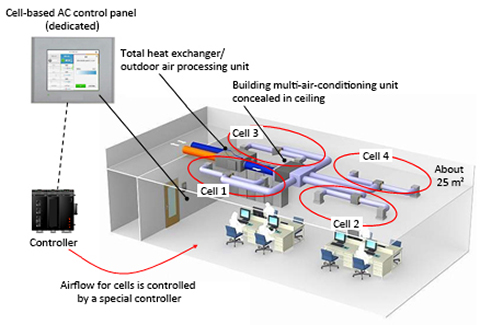
Figure 1.Air conditioning system for controlling airflow and direction in cells (about 25 m²)
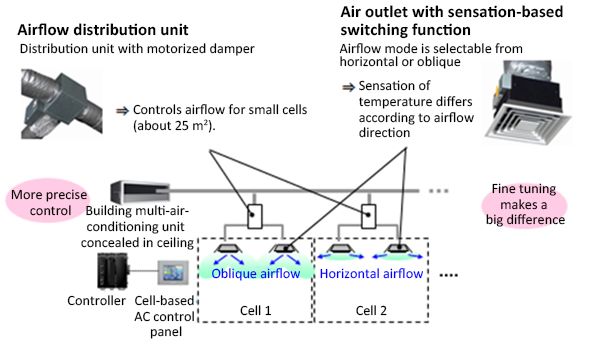
Figure 2. Introduction of Azbil’s unique cell-based airflow distribution units and air outlets with an airflow switching function enables fine control of airflow from an almost imperceptible quiet flow to a feeling of flowing air in order to provide the right temperature sensation.
- Individual control and improved-satisfaction
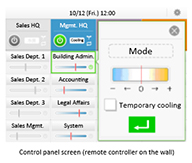
Figure 3. Satisfaction with air conditioning is improved by allowing users to change the settings by themselves (giving them the right to select their environment).
The system gives users control of the settings for the cell they are in, so that they have the ability to select their environmen [*2] and have a feeling of control [*3]. Users can make themselves comfortable by changing the airflow volume and direction without changing the temperature setpoint. In this way comfort can be improved while maintaining energy efficiency.
Generally with air conditioning systems, the control panel is controlled only by the building operators. If the settings are not comfortable, office workers may feel that they are forced to work in an environment that they cannot change.
Azbil’s new system allows the users to change the air conditioning settings by themselves. Therefore, they can have a feeling of control, with the right to select their environment, so their satisfaction with the air conditioning will be much improved.
Also, allows users to tweak the temperature setting in a relative way (“cooler” or “warmer”), based on their feeling, rather than setting a specific temperature number. The airflow volume and direction (horizontal or oblique) can be changed in order to improve the user’s physical sensation without changing the temperature setpoint. The system thereby improves comfort while helping to save energy. If changing the airflow volume and direction is not sufficient to improve comfort, the temperature setpoint can be changed as the next step.
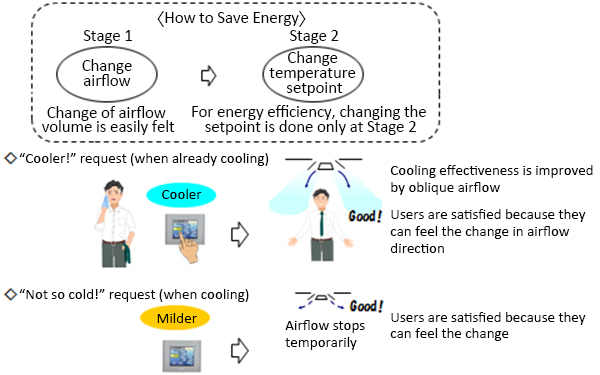
Figure 4. Basically, changing the airflow volume and direction only makes the environment comfortable, but the temperature setpoint can be changed if necessary.
- Improving energy conservation by implementing Eco-mode
Eco-mode incorporates Azbil’s energy-conservation know-how. For example, in the summer when the outdoor temperature is high, the system saves energy without sacrificing comfort by periodic setpoint oscillation between 26 and 28℃ in order to moderate room cooling. In the spring or autumn when the outdoor temperature is low, the system extends the amount of cooling time that uses only outdoor air, in order to further conserve energy.
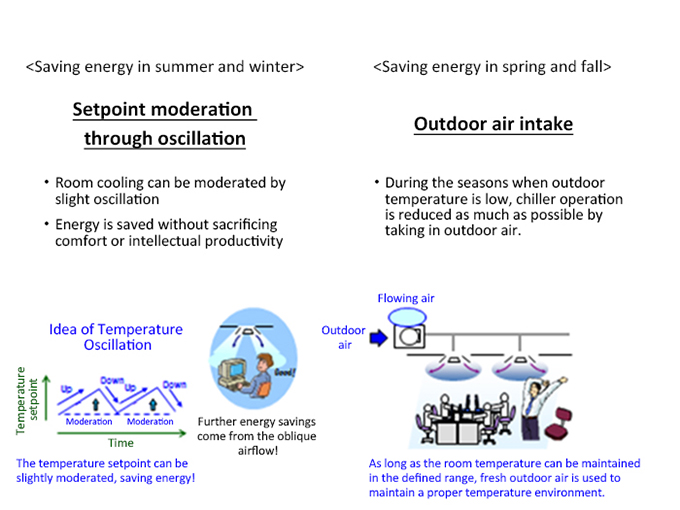
Figure 5. Implementation of Eco-mode, which varies the cooling setpoint in order to moderate room cooling and conserve energy.
In conclusion, we estimate that the energy consumption of an office with a floor size of 5000㎡ can be reduced by 900,000 yen per year by taking advantage of the following features:
1. Reduction of areas that are excessively cooled by implementing cell-based control
2. Changing the airflow volume and direction to change people’s temperature sensations without changing the temperature setpoint of the AHU
3. Using oscillating control to moderate the temperature setpoint, and using Eco-mode to take in outdoor air.[*2] Right to select the environment: the concept that satisfaction is improved by allowing users to choose their environmental conditions, such as temperature, as compared to when the conditions are set by others. This was proposed by Tatsuo Yabe, professor in the Faculty of Architecture of Kogakuin University.
[*3] Feeling of control: this is a term in psychology referring to the feeling that comes from achievement through one's own actions.
Results and Future Outlook
Providing a comfortable environment and improving the value of buildings by human-centered air conditioning
Azbil Corporation has opened a demonstration showroom in the Nishi-kamata neighborhood of Ota (Tokyo Prefecture) where you can experience the system for yourself. Also, our employees have been evaluating it in offices close to the showroom. Currently, satisfaction with the air conditioning is high and there are no complaints about the temperature setpoint. The cell-based system, which became available in August 2015, is designed for new small and medium sized buildings that have building multi-air-conditioning units. We will enhance the system by implementing the following functions:
- Developing an air outlet, with the airflow adjustment function, that can be attached to existing ducts
- Enabling application to central air conditioning systems of larger buildings
- Developing an application program to operate the system through smartphones, etc.
As listed above, the product’s scale will be expanded and usability will be improved.
Azbil’s new air conditioning system increases the value of buildings and provides a comfortable environment for office workers based on a cell-based control concept, with improved response to individuals’ temperature sensations. Azbil Corporation, guided by its ideal of “human-centered automation,” plans to continue to develop air conditioning systems that put people first.
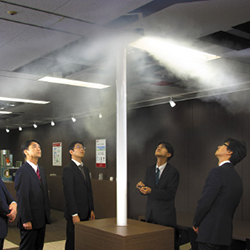
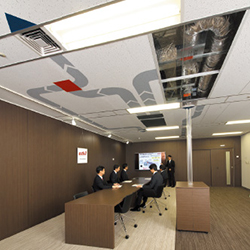
Azbil’s showroom where you can experience the new air-conditioning system.
An industry-leading coupled simulation environment for an entire air conditioning system
Azbil Corporation has been researching and developing next-generation air conditioning systems, including its new cell-based product. As a part of this effort, we are developing a simulator for an entire air-conditioning system.
Joint research is being conducted with the School of Fundamental Science and Engineering of Waseda University. The following simulator and tools are being coupled [*4] to build the simulated environment:
- “Energy Flow + M” (supplied by Waseda Univ.). This is a general-purpose energy system analysis simulator building’s multi-air-conditioning unit.
- FlowDesigner (supplied by Advanced Knowledge Laboratory, Inc.). This is a commercially available analysis tool for airflow and thermal distribution.
- MATLAB/Simulink (supplied by The MathWorks, Inc.). This is a commercially available modeling tool for the entire control system. This coupled environment for simulation will be among the most advanced in the air conditioning industry.
Using this simulation environment, we modeled the cell-based air conditioning system. Setting the initial conditions of window-side temperature in direct sunlight of 37℃, temperature in the corner of the room as 33℃(see Fig. 6-a), and cooling with 16℃ chilled air for 180 minutes. A comparison of Fig. 6-b (conventional method) and Fig. 6-c (cell-based air conditioning method), shows that the cell-based method, with increased airflow on the window side, is effective in equalizing the temperature distribution in the room. In other words, fine control of the temperature can be achieved by dividing a room into small cells.
This simulation environment was used in the development of the new system. Optimum solutions for the system’s PID control parameters were obtained from the simulation and used in the actual control logic.
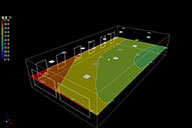
(a)
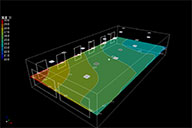
(b)
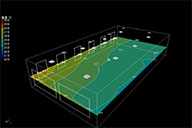
(c)
Figure 6. Effectiveness of cell-based air conditioning (c) according to the simulation
[*4] Coupled: In this analysis method, in order to precisely understand two or more physical phenomena, the result of one simulation is input to another one.
*Handling of products and services described in “azbil techne” may differ by country or region.
- Azbil Corporation Info
- Corporate Philosophy / Symbol / Policies
- azbil Group Corporate Social Responsibility
- Investor Relations
- Digital Transformation (DX)
- Medium-term Plan
- Research & Development
- Production
- Safety and Dependability of Products and Services
- Procurement
- Exhibitions & Seminars
- Public Relations
- azbil Group
- Certifications
- Global Network
